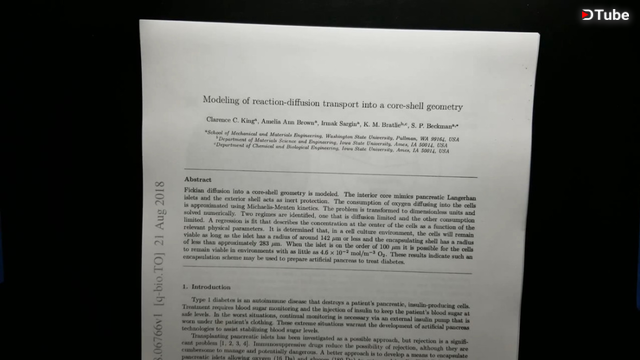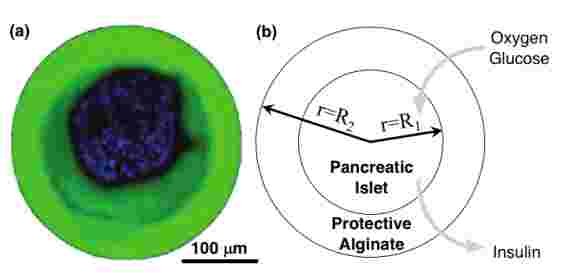
Overview
This is a manuscript that is very different from most of my prior work. It was a unfunded project in collaboration with an associate from ISU. In many regards this is a simplistic perspective of artificial pancreas structures and their performance, but it is good scale project for an undergraduate student in engineering, an over the past several years I've had multiple undergraduate engineers work on the problem. I have ideas for how to expand upon it, but it would be helpful to first find a student that is interested.
Abstract
Fickian diffusion into a core-shell geometry is modeled. The interior core mimics pancreatic Langerhan islets and the exterior shell acts as inert protection. The consumption of oxygen diffusing into the cells is approximated using Michaelis-Menten kinetics. The problem is transformed to dimensionless units and solved numerically. Two regimes are identified, one that is diffusion limited and the other consumption limited. A regression is fit that describes the concentration at the center of the cells as a function of the relevant physical parameters. It is determined that, in a cell culture environment, the cells will remain viable as long as the islet has a radius of around 142 micrometer or less and the encapsulating shell has a radius of less than approximately 283 micrometer. When the islet is on the order of 100 micrometer it is possible for the cells to remain viable in environments with as little as 4.6x10^2~mol/m^-3 O2. These results indicate such an encapsulation scheme may be used to prepare artificial pancreas to treat diabetes.
Manuscript
Here I summarize the work, but the full manuscript can be found on the arXiv: https://arxiv.org/abs/1808.06766
▶️ DTube
▶️ IPFS
UPDATE: On September 23, 2018 this manuscript was accepted in the Journal of Theoretical Biology.
Hurray!!!
Congrats! Getting a manuscript published is one of the most satisfying aspects of research.
Maybe this will convince me to dig up some of my old research from grad school and toss it up on Steemit :)
Seeing Original Research here on STEEM is obviously fantastic, there's no praise from me who's not a member of #steemstem that would seem reasonable here so I'll just shut up about that now and say: GOOD!
Onto less important things:

For a moment I had to wonder if having a banner, like the image of the encapsulated cell cluster below (but in better quality, obviously)
Would make for a better attention-grabber in the feed -- who doesn't love cell close-ups! But then the value of having the video there in the header is probably greater -- so many articles posted under #steemstem have static banners so a video would naturally stand out. But perhaps adding a relevenat image banner to your next video would not hurt.
Yes, this is what I should have done, but its too late now. I'm going to leave this one alone and the next paper, which will probably be coming in 1-2 months, I'll select a better figure.
That's a nice overview of your research manuscript.
I haven't looked in detail at the equations yet but on first glance it might be possible to rigorously prove the existence of solutions satisfying the boundary conditions (by analytical methods or rigorous numerics). Is this something you would be interested in?
Posted using Partiko Android
If you're interested, the problem I want to solve involves modifying this problem to better represent the coupling of glucose and oxygen.
https://www.ncbi.nlm.nih.gov/pmc/articles/PMC3138450/
In part, you might think that this will hamper the cell life, because glucose is about 100X bigger than O2, but the consumption rate is coupled, so we have diminished consumption of O2. It might be that we have a system completely saturated with O2 so the cell life isn't limited by oxygen, but something else.
It is also noteworthy that I'm only looking at the steady state solution. If we are thinking about Insulin, the transient solution is also very important. If, for example, the cells get the signal to dump insulin, but it takes too long for the insulin to reach the blood, then there might be an overshoot and the patient will have a hypoglycemic response, which also can be deadly.
I think getting a transient solution is going to be a bear. I tried expressing the solution for the simple problem given here as a Fourier expansion, and the results wouldn't converge.
Again, I have zero funds for this, so as a result I find myself waiting to find an undergraduate engineering student that is willing to work for free. I'd try to write for financial support, but since this is way outside of my area of experience, I have almost to probability of funding. (Funding agents very much like to support you to continue the same work you already have proven yourself with.)
I think it is first best to make the results in the manuscript more rigorous and then see if it is possible to extend these to the coupled system.
A steady state solution is not useful if you don't have well-posedness and stability results for the underlying PDE. A full stability results is always complicated but a linear stability result might be possible. But for this you need to obtain the existence of the steady state solution. I wil discord dm you about it at a later time.
This post has been voted on by the steemstem curation team and voting trail.
There is more to SteemSTEM than just writing posts, check here for some more tips on being a community member. You can also join our discord here to get to know the rest of the community!
Are you the Scott in Gray-Scott model? :P Great to see this work man! I have done few simulations in Reaction-Diffusion in past. But now I do all-atom molecular dynamics. :)